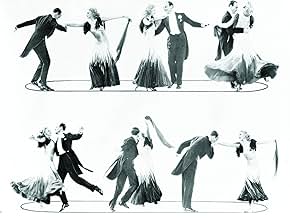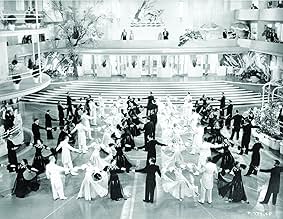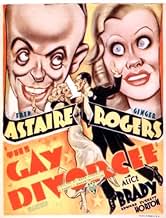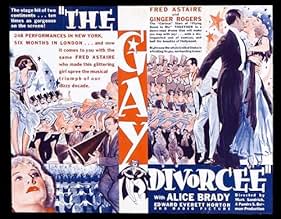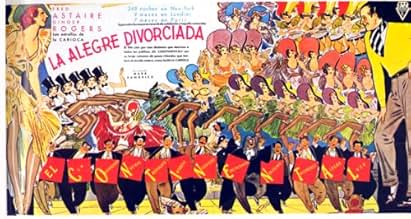ÉVALUATION IMDb
7,4/10
8,9 k
MA NOTE
Ajouter une intrigue dans votre langueA woman thinks a flirting man is the co-respondent her lawyer has hired to expedite her divorce.A woman thinks a flirting man is the co-respondent her lawyer has hired to expedite her divorce.A woman thinks a flirting man is the co-respondent her lawyer has hired to expedite her divorce.
- A remporté 1 oscar
- 1 victoire et 5 nominations au total
Norman Ainsley
- Undetermined Role
- (uncredited)
Jimmy Aubrey
- Undetermined Role
- (uncredited)
Finis Barton
- Undetermined Role
- (uncredited)
Eleanor Bayley
- Dancer
- (uncredited)
De Don Blunier
- Chorus Girl
- (uncredited)
Pokey Champion
- Dancer
- (uncredited)
Jack Chefe
- Night Club Patron
- (uncredited)
Histoire
Le saviez-vous
- AnecdotesThe musical number "The Continental" lasts 17 1/2 minutes, the longest number ever in a musical until Gene Kelly's 18 1/2-minute ballet at the end of Un Américain à Paris (1951) 17 years later. It is also the longest musical number in all of Fred Astaire and Ginger Rogers' films together.
- GaffesCrew member coughs after the chase scene, picnic basket on running board and he's going through item list directly after she says, "After that."
- Citations
Tonetti: [unable to remember his passphrase "Chance is a fool's name for fate," Tonettie repeatedly muffs it] Chance is the foolish name for fate. / Give me a name for chance and I am a fool. / Fate is a foolish thing to take chances with. / I am a fate to take foolish chances with. / Chances are that fate is foolish. / Fate is the foolish thing. Take a chance.
- Autres versionsIn the version of the movie released in Brazil in the 1930s, the Brazilian actor Raul Roulien sang in the musical number "The Continental".
- ConnexionsEdited into Joan of Paris (1942)
- Bandes originalesDon't Let It Bother You
(1934)
Music and Lyrics by Mack Gordon and Harry Revel
Dance performed by Fred Astaire
Commentaire en vedette
Guy Holden, the celebrated stage dance star, is touring Europe on vacation. Mimi Glossop is a rich American living in London and is currently in the throes of a divorce. They meet, they dance, they fall in love.
Ginger Rogers was by far the bigger cinema star when RKO Radio teamed her with Fred. She had appeared in 34 films to his 3, and two in the previous year had been smash hits - "Golddiggers" and "42nd Street". This loose borrowing from Cole Porter's Broadway show contains only one of the master's songs, the immortal "Night And Day", and only four other songs in the entire movie - Conrad & Magidson's "Needle In A Haystack" and "The Continental", and Gordon & Revel's "Don't Let It Bother You" and "Let's K-nock K-nees" (featuring an 18-year-old Betty Grable, who had herself featured in no less than eight films in the previous year).
At the depth of the Depression, this sort of film was all the rage - a fantasy of carefree opulence and ease, set in a world of Parisian floorshows, ocean liners and tuxedos. The wit is sharp and the mood flirtatious. What if the film-makers hadn't the first clue about how an English barrister conducts his cases? This is about romance, not professional ethics. What if the terrain of Brighton isn't an igneous intrusion, but in fact a sedimentary accretion? This is about two people's sublime dancing, not geology.
Fred is as always the quintessence of style, a naturally elegant creature, and Ginger is gorgeous. The plot is very well constructed, containing all the misunderstandings associated with musical farce, but developing them with panache. The denouement is both neat and unexpected. There are plenty of girls dancing in the usual geometric patterns, but there is also abundant creativity in the choreography - the playful steps in "The Continental", for example, or Fred's reluctant dance for his supper. Mimi is trying to resist Guy, and has to be drawn into "Night And Day" against her will - an instance of character being expressed through dance. Max Steiner's arrangement of this number is glorious, with its 'tacit', and the swelling fortissimos, and a dainty countermelody in the strings. Ginger sings "The Continental" like an angel, nicely ragging the time.
Inconsequential? No doubt. Frothy? Certainly. A joy to watch? Definitely!
Ginger Rogers was by far the bigger cinema star when RKO Radio teamed her with Fred. She had appeared in 34 films to his 3, and two in the previous year had been smash hits - "Golddiggers" and "42nd Street". This loose borrowing from Cole Porter's Broadway show contains only one of the master's songs, the immortal "Night And Day", and only four other songs in the entire movie - Conrad & Magidson's "Needle In A Haystack" and "The Continental", and Gordon & Revel's "Don't Let It Bother You" and "Let's K-nock K-nees" (featuring an 18-year-old Betty Grable, who had herself featured in no less than eight films in the previous year).
At the depth of the Depression, this sort of film was all the rage - a fantasy of carefree opulence and ease, set in a world of Parisian floorshows, ocean liners and tuxedos. The wit is sharp and the mood flirtatious. What if the film-makers hadn't the first clue about how an English barrister conducts his cases? This is about romance, not professional ethics. What if the terrain of Brighton isn't an igneous intrusion, but in fact a sedimentary accretion? This is about two people's sublime dancing, not geology.
Fred is as always the quintessence of style, a naturally elegant creature, and Ginger is gorgeous. The plot is very well constructed, containing all the misunderstandings associated with musical farce, but developing them with panache. The denouement is both neat and unexpected. There are plenty of girls dancing in the usual geometric patterns, but there is also abundant creativity in the choreography - the playful steps in "The Continental", for example, or Fred's reluctant dance for his supper. Mimi is trying to resist Guy, and has to be drawn into "Night And Day" against her will - an instance of character being expressed through dance. Max Steiner's arrangement of this number is glorious, with its 'tacit', and the swelling fortissimos, and a dainty countermelody in the strings. Ginger sings "The Continental" like an angel, nicely ragging the time.
Inconsequential? No doubt. Frothy? Certainly. A joy to watch? Definitely!
- stryker-5
- 13 mars 1999
- Lien permanent
Meilleurs choix
Connectez-vous pour évaluer et surveiller les recommandations personnalisées
- How long is The Gay Divorcee?Propulsé par Alexa
Détails
Box-office
- Budget
- 520 000 $ US (estimation)
- Brut – à l'échelle mondiale
- 6 879 $ US
- Durée1 heure 47 minutes
- Couleur
- Rapport de forme
- 1.37 : 1
Contribuer à cette page
Suggérer une modification ou ajouter du contenu manquant

Lacune principale
By what name was The Gay Divorcee (1934) officially released in India in English?
Répondre


